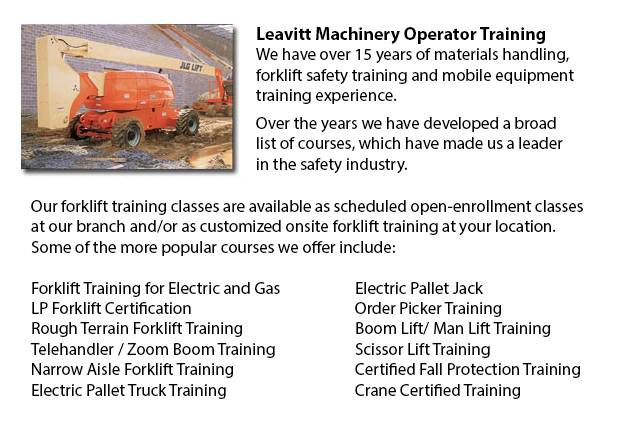
Manlift Training Tukwila - There are a lot of manlift training courses that provide a review of the manlift equipment. The practicum part of the training is one more essential portion of the course. In this part the trainee has chance to demonstrate their practical abilities, their ability to safely operate a manlift. A prerequisite to Manlift training is the fall protection training, that could be included in the training according to the particular needs of the client.
Course Content
The program content consists of: the effect of performing unsafe acts or using unsafe equipment, pre-shift machine check and work area survey requirements, Review of load capacities, Lifting devise machine definitions, safety decals and specific equipment requirements, Review of related sections of the CSA Standards and the OHSA Standards and Review site particular Hazards, together with controls for safely operating a lifting device.
Demonstration and Evaluation Content
The evaluation and demonstration part of the course includes: making use of a spotter or a signaler when required; Proper personal protective equipment or also referred to as P.P.E. as required; Utilizing the right fitting harness or fall arrest devise; Operating a lift only on solid and level ground; Aware of load limits etc. and other specs set out by the manufacturer; Operating the lift with all other staff clear of the job place; Pre-shift work area survey and equipment inspection; Having all associated machines stored safely on the lift platform; Ensuring a safe and smooth operating speed for different plant conditions and isolating off the work area when major work projects are to be done.
Each person will be tested to make sure they could efficiently and safely use your site-specific equipment.
Manlift Safety
As the manlift is capable of lifting materials and personnel over 20 feet in the air, these machinery pose a particular amount of danger and could be dangerous machinery if not operated correctly. Since the danger is so apparent, lift owners and operators are careful to properly maintain their machinery and follow proper safety measures and operating procedures. The ratio of accidents involving this particular machine is fairly low.
The safety specifications for scissor lifts and boom lifts puts the burden for safe manlift operation on the user. You are responsible for understanding how to safely operate the lift even if you just lease the machinery for one day. The most basic safety features on the machine are safety decals and the operating manual. These show vital information about the safety equipment, maintenance and operating procedures.
Newer lift models will come with manuals and decals in place. Technically, the operating guidebook should be stored on the lift itself. If you are purchasing a used lift, it is important to ensure that the guidebook is included and that important decals haven't been painted over. The restraints that prevent operators from falling and the guardrails are other essential safety features. These are mandatory and standard on all types of lifts.
-
Forklift Train The Trainer Tukwila
Forklift Train The Trainer Tukwila - We provide amongst the best Forklift Training programs within North America, using the latest and most advanced training techniques. Amongst our training courses are Train the Trainer courses, mobile equipment ope... More -
Crane Certification Tukwila
Crane Certification Tukwila - The Crane Certification training program covers content suggested by industry concerning the safe and efficient operation of cranes. People training will learn the following: pre-operational, operational and post operati... More -
Manlift Safety Training Tukwila
Manlift Safety Training Tukwila - It is vital for competent Manlift operators to be aware of the associated dangers which come with specific types of scissor lifts. They need to be able to operate the scissor lift in a way which protects not just the... More -
Scissor Lift Training Tukwila
Scissor Lift Training Tukwila - While operating a scissor lift, they must be utilized proficiently so as to protect the safety of the other personnel in the workplace and to protect the safety of the machine. Skilled operators are trained to drive th... More -
Crane Operator Certification Tukwila
Crane Operator Certification Tukwila - Crane Operator Certification is a process which permits people to earn a certificate to operate certain kinds of cranes. Certification includes classroom learning, hands-on practice and an ability evaluation. Se... More -
Forklift Operator Certification Tukwila
Forklift Operator Certification Tukwila - Certification for forklifts are required to guarantee the safe utilization of forklifts for those employers in construction, industrial and warehouse environments. The training has to include a method of educ... More -
Boom Lift Ticket Tukwila
Boom Lift Ticket Tukwila - Boom Lifts are a platform lift apparatus which can be raised or lowered to differing heights, making this apparatus a useful tool for various manufacturing uses. There are many distinctive types of Boom Lift consisting of k... More -
Bucket Truck Training Tukwila
Bucket Truck Training Tukwila - The bucket truck training program is a program that is designed to efficiently train qualified operators so they could lessen the chance of personal injury and incident when working in close proximity to or with bucket... More

Forklift Training Tukwila
TOLL FREE: 1-888-254-6157
Tukwila, Washington
forklifttrainingtukwila.com
Email Us
About Us


